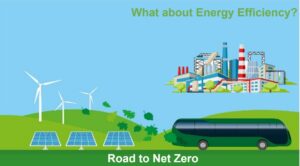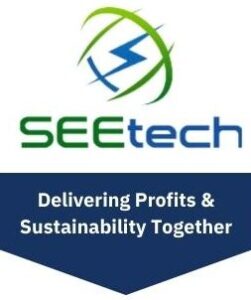
Where are we missing the bus on the journey to Net Zero?
I recollect Padu Padmanabhan, a legend in energy efficiency (EE), raised the beautiful phrase “Energy Efficiency as the First Fuel” long back in 1990s (Book- First Fuel: India’s Energy Efficiency Journey and a Radical Vision for Sustainability published in 2021). He explained this nicely in his recently published book with the same title. We also see a shortage in coal supplies, power plants getting closed for want of imported coal, and a hefty rise in petroleum fuel for commercial usages such as natural gas, LPG, and diesel. At the same time, we also see a surge in energy demand due to growth in the Indian economy and a growing share of solar & other renewables in total electricity generation, which is good news. There is a movement towards reducing carbon emissions and ideally aiming to become Net-Zero. However, this is with a very long target, 2050-2070.
Therefore, it becomes imperative to ask several fundamental questions to ourselves, such as How to make economic growth environmentally sustainable? As the net-zero targets are pretty futuristic, what is that which we need to do today? Most organizations have sustainability as their essential agenda, but the burning question is whether it is sufficient? Are their Net-Zero plans ready? Are all the options for reducing energy costs and carbon footprints sincerely explored? Is it not that with very long targets, we tend to postpone what can be done today? Frankly speaking, answers to most of these questions are a big NO except the last one, YES; when such a situation is there with the corporate, What can be expected from the MSMEs, which have a very significant role in the Indian economy. Net-zero is such a daunting task that it can not be achieved by shifting to renewables (Rooftop Solar PV or Open Access options, one is limited by the rooftop area available while the other applies to more significant consumers, i.e. beyond 1MW Contract Demand). We do see some great initiatives by some of the leading corporations wherein they shifted to renewable fuel (biomass-based briquettes) for their thermal energy demands in boilers or thermic fluid heaters. Utilizing entire rooftop space and even increasing the Contract Demand to have the highest possible capacity of Solar Rooftop PV but still unable to reach Net-Zero Energy. The reason is that EE is not yet explored beyond LEDs. EE is not as straightforward as Solar PV or Open Access in reducing energy costs despite EE technologies being as many as the number of medicines in a pharmacy shop. The point to be noted is that EE has half the payback of Rooftop Solar PV investments. EE only asks for the competence needed to identify and implement EE projects. Dear decision-makers – Ignorance is not bliss here.Friends, the point I wish to make through this blog is that despite realizing and raising the essential reality 2-3 decades back and envisioning Energy Efficiency as the First Fuel, EE remains at the backdoor and does not find its space in corporate strategy at the front yet. During several conversations, I have been told that EE is in KRA at the team or individual level; it’s not the board room issue. We carry out Energy Audits regularly, and implement some EE initiatives every year; we are winning in EE competitions at the national level; our SEC (Specific Energy Consumption) is among the best in the industry; what more do you expect? Budget is less for EE, however, it’s there every year. Don’t worry we have put this EE project in the next year’s budget (as if EE is the supplier’s need, I mean Energy Auditor or ESCO or OEM for EE) and so on. ESCOs are limited, our country is too large therefore everyone has to play their role. End of the day, the direct beneficiary is the energy end user therefore to make EE happen Enduser has to be in the driver seat. Let me share a few cases of what EE has delivered and the enormous potential it offers to the energy end-user to reduce the carbon footprints and the corresponding energy cost to make the sustainability-led investments financially feasible. I lead an ESCO called SEE-Tech Solutions, have successfully reduced the overall energy consumption & its cost by over 20% in a leading hospitality chain in India with more than 15 properties. Yes, identifying the opportunities and implementation of the EE projects was not as simple as Solar PV but achieved by identifying and implementing 6 to 10 EE technologies that are not the same in all cases. Here, it is to be noted that electrically operated technologies removed Diesel or Gas consumption as a thermal energy source. Like us, several other ESCOs are doing an excellent job in the country. OEMs & their representatives are also doing an excellent position to deliver EE.Let’s also see glimpses of the EE basket that it offers to the energy end-user and why I say WE can be the starter, thus leading the movement towards achieving Net Zero today. More than 80% of the electricity is consumed in the manufacturing industry and commercial buildings through electrical motors. Here, EE offers IE4 & IE5 motors and SEE-Tech runs a program for deploying these Motors delivering up to 10% savings in 30 to 45 KW motors, 10 to 15% savings in 10 to 22.5 KW motors and up to 25% savings in motors lesser than 10 KW and all delivering a payback period of fewer than two years and life of over ten years. I have elaborated on this in my earlier blog “Is your motor taking a toll on your pocket”. Options are there for larger motors as well. Isn’t it a dichotomy that we accept Solar PV investments which are also larger in size and surely double the payback period of EE?Still, EE is not getting priority. Ignorance is NOT bliss here. EE needs to be a demand-driven field (pulled by the corporate) then supply-driven (pushed by the ESCOs) as the energy end-user is the ultimate beneficiary. Also, see the other side with EE for the motors; the law mandates IE2 for new motors, nothing to rewind and keep using old motors, and the national program (EESL) has used only IE3 in its replacement program. If the existing motors are replaced by IE2 or IE3 (and called EE projects) or the new motors are bought as IE3, shifting to IE5 will never be financially feasible as the baseline will be raised. Observe closely. In India, we go directly to EV from petrol or diesel cars, not the hybrids finding their space. Such strategic aspects in decision making are getting missed. The fact remains, whether we know it or not, in many cases, the cost of a motor is less than the cost of running it for 12 to 15 months. Again, Ignorance is NOT bliss here.Let’s see hydraulic presses or injection moulding machines, for want of low capital investment still induction motor is being preferred in case of a Servo Motor and opportunity to save up to 30% in energy consumption is getting ignored, again payback period is less than two years in many cases. Be it plastic, auto ancillary, and many other industries have this opportunity with EE. With thermal energy and most electrical utilities, the situation is unique – all the utilities are continuous (operate based on pressure or temperature) while the consumption of these utilities is in batches – be it pharma or many chemical and allied industries. This is the genesis of losses which the field of EE can address. Air is free, but compressed air is not. It is to be noted that air compressors have an efficiency level of 22%. Despite having a waste heat recovery option from compressed air, heat pump usage is possible for generating hot water (which is more cost-effective than LPG/Diesel/NG). Still, these fuels are fired to get hot water, why? Are these not the questions to be asked to decision-makers? EE is not finding its space with decision-makers despite many EE improvement options. Why is the scope for EE improvement increasing with time in many manufacturing facilities and commercial buildings? I or any EE professional can go on and on with EE technology options available for deployment; however, the concern remains that the rate of adoption of EE technologies is still poor. For me, one of the primary reasons is that EE has still not found its position in the corporate strategy room and priorities. The point here to be noted is that these EE investments demand just 5 to 10% of the total investment already made in the plant & machinery while setting up the facility and delivering up to 20% savings in most manufacturing facilities and commercial buildings. EE initiatives, even planned at scale, also do not demand investment levels of Solar PV, which many corporations are making as their sustainability initiative. However, EE investment (lesser in size) and double the payback period are not finding its priority. You would agree that the onus of such a contrasting situation finally goes on to the decision-makers. Indeed, Ignorance is NOT bliss here, and this is precisely where we are missing the bus in the race to Net-Zero. It’s Better Late Than Never… Let the journey of EE start with the intent to cater to the potential that EE offers and not the customary execution of a few EE projects every year.
